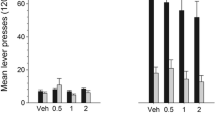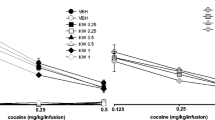Abstract
Recent evidence suggests that the putative dopamine (DA) autoreceptor antagonists, (+)-AJ 76 and (+)-UH 232, share some neurochemical and behavioral effects with both psychostimulants and neuroleptics. The ability of (+)-AJ 76 and (+)-UH 232 to mimic or antagonize the stimulus effects of cocaine was investigated in rats trained to discriminate 5 mg/kg (N=8) or 10 mg/kg (N=8) of cocaine from saline in a two-lever, water-reinforced, drug discrimination task. In the cocaine (10 mg/kg) group, administration of (+)-AJ 76 (2.5–20 mg/kg) engendered only a partial substitution for cocaine (maximum 60% cocaine-lever responses). Given in combination with cocaine (10 mg/kg), (+)-AJ 76 (2.5–40 mg/kg) did not significantly attenuate the cocaine cue. A fixed dose of (+)-AJ 76 (2.5 or 10 mg/kg) plus various doses of cocaine (1.25–5 mg/kg) did not alter the cocaine dose-response curve. (+)-UH 232 (2–16 mg/kg) produced primarily saline-appropriate responding in rats trained to discriminate 5 mg/kg of cocaine and was unable to block the interoceptive cocaine state when given in combination with cocaine (5 mg/kg). (+)-UH 232 (2 or 8 mg/kg) also did not alter the cocaine dose-response curve. These results suggest that (+)-AJ 76 and (+)-UH 232 elicit only weak or no cocaine-like stimulus effects and, unlike neuroleptics, do not attenuate the cocaine cue.
Similar content being viewed by others
References
Appel JB, White FJ, Holohean AM (1982) Analyzing mechanism(s) of hallucinogenic drug actions with drug discrimination procedures. Neurosci Biobehav Rev 6:529–536
Bergstrom DA, Beninato M, Walters JR (1988) Neurophysiological effects of (+)-UH 232 and (+)-AJ 76, dopamine autoreceptor antagonists, on dopamine pre- and postsynaptic receptors. Soc Neurosci Abstr 14:1077
Callahan PM, Appel JB, Cunningham KA (1991) Dopamine D1 and D2 mediation of the discriminative stimulus properties ofd-amphetamine and cocaine. Psychopharmacology 103:50–55
Childress A, Ehrman R, McLellan A, O'Brien C (1988) Update on behavioral treatments for substance abuse. In: Harris LS (ed) Problems of drug dependence. National Institute on Drug Abuse, Rockville, MD, pp 183–192
Colpaert FC, Niemegeers CJE, Janssen PAJ (1978) Neuroleptic interference with the cocaine cue: internal stimulus control of behavior and psychosis. Psychopharmacology 58:247–255
Colpaert FC, Niemegeers CJE, Janssen PAJ (1979) Discriminative stimulus properties of cocaine: neuropharmacological characteristics as derived from stimulus generalization experiments. Pharmacol Biochem Behav 10:535–546
Cunningham KA, Appel JB (1982) Discriminative stimulus properties of cocaine and phencyclidine: similarities in the mechanism of action. In: Colpaert FC, Slangen JL (eds) Drug discrimination: application in CNS pharmacology. Elsevier/North Holland, Amsterdam, pp 181–192
Cunningham KA, Callahan PM (1991) Monoamine reuptake inhibitors enhance the discriminative state induced by cocaine in rats. Psychopharmacology 104:177–180
Dourish CT, Herbert EN, Iversen SD (1989) Blockade of apomorphine-induced yawning in rats by the dopamine autoreceptor antagonist (+)-AJ 76. Neuropharmacology 28:1423–1425
Dworkin SI, Smith JE (1988) Neurobehavioral pharmacology of cocaine. In: Clouet D, Ashgar K, Brown R (eds) Mechanisms of cocaine abuse and toxicity. Research monography 88, National Institute on Drug Abuse, Rockville, MD, pp 185–197
Fischman MW, Schuster CR (1982) Cocaine self-administration in humans. Fed Proc 41:241–246
Fischman MW, Foltin RW, Nestadt G, Pearlson GD (1990) Effects of despiramine maintenance on cocaine self-administration by humans. J Pharmacol Exp Ther 253:760–770
Hajos M, Hjorth S, Svensson K, Carlsson A (1988) In vivo dopamine (DA) receptor binding and behavioral effects of the putative DA autoreceptor antagonists (+)-AJ 76 and (+)-UH 232-in rats with a unilateral nigral 6-OH-DA lesion. Exp Brain Res 70:577–584
Kleven MS, Anthony EW, Goldberg LI, Woolverton WL (1988) Blockade of the discriminative stimulus effects of cocaine in rhesus monkeys with the D1 dopamine antagonist SCH 23390. Psychopharmacology 95:427–429
Lehmann J, Briley M, Langer SZ (1983) Characterization of dopamine autoreceptor and [3H]-spiperone binding sites in vitro with classical and novel dopamine receptor agonists. Eur J Pharmacol 88:11–26
Martin WR, Sloan JW, Sapira C, Fibiger HC (1971) Physiologic, subjective and behavioral effects of amphetamine, ephedrine, phenmetrazine, and methylphenidate in man. Clin Pharmacol Ther 12:245–258
Moghaddan B, Bunney BS (1989) Differential effect of cocaine on extracellular dopamine levels in rat medial prefrontal cortex and nucleus accumbens: comparison to amphetamine. Synapse 4:156–161
Piercey MF, Lum JT (1990) Electrophysiological effects of dopaminergic autoreceptor antagonists, (+)-AJ 76 and (+)-UH 232. Eur J Pharmacol 182:219–226
Scheel-Kruger J, Braestrup C, Nielson M, Golembrowska K, Mogilnicka E (1977) Cocaine: discussion on the role of dopamine in the biochemical mechanism of action. In: Ellinwood EH, Kilbey M (eds) Cocaine and other stimulants. Plenum Press, New York, pp 373–407
Sokoloff P, Giros B, Martres MP, Bouthenet ML, Schwartz JC (1990) Molecular cloning and characterization of a novel dopamine receptor (D3) as a target for neuroleptics. Nature 347:146–151
Svensson K, Johansson AM, Magnusson T, Carlsson A (1986) (+)-AJ 76 and (+)-UH 232: central stimulants acting as preferential dopamine autoreceptor antagonists. Naunyn-Schmiedeberg's Arch Pharmacol 274:5–14
Waters N, Lofberg L, Svensson K, Carlsson A (1990) Increased dopamine release by the autoreceptor antagonist (+)-AJ 76 is Ca2+-dependent. Eur J Pharmacol 187:425–434
Weiss RD (1988) Relapse to cocaine abuse after initiating desipramine treatment. JAMA 260:453–457
White FJ, Wang RY (1984) Pharmacological characterization of dopamine autoreceptors in the rat ventral tegmental area: microiontophoretic studies. J Pharmacol Exp Ther 231:275–280
Wood DM, Emmett-Oglesby MW (1987) Evidence for D2 receptor involvement in tolerance to the discriminative stimulus properties of cocaine. Soc Neurosci Abstr 3:1717
Wood DM, Emmett-Oglesby MW (1989) Mediation in the nucleus accumbens of the discriminative stimulus produced by cocaine. Pharmacol Biochem Behav 33:453–457
Author information
Authors and Affiliations
Rights and permissions
About this article
Cite this article
Callahan, P.M., Piercey, M.F. & Cunningham, K.A. Effects of the putative dopamine autoreceptor antagonists (+)-AJ 76 and (+)-UH 232 on the discriminative stimulus properties of cocaine. Psychopharmacology 107, 73–77 (1992). https://doi.org/10.1007/BF02244968
Received:
Revised:
Issue Date:
DOI: https://doi.org/10.1007/BF02244968




